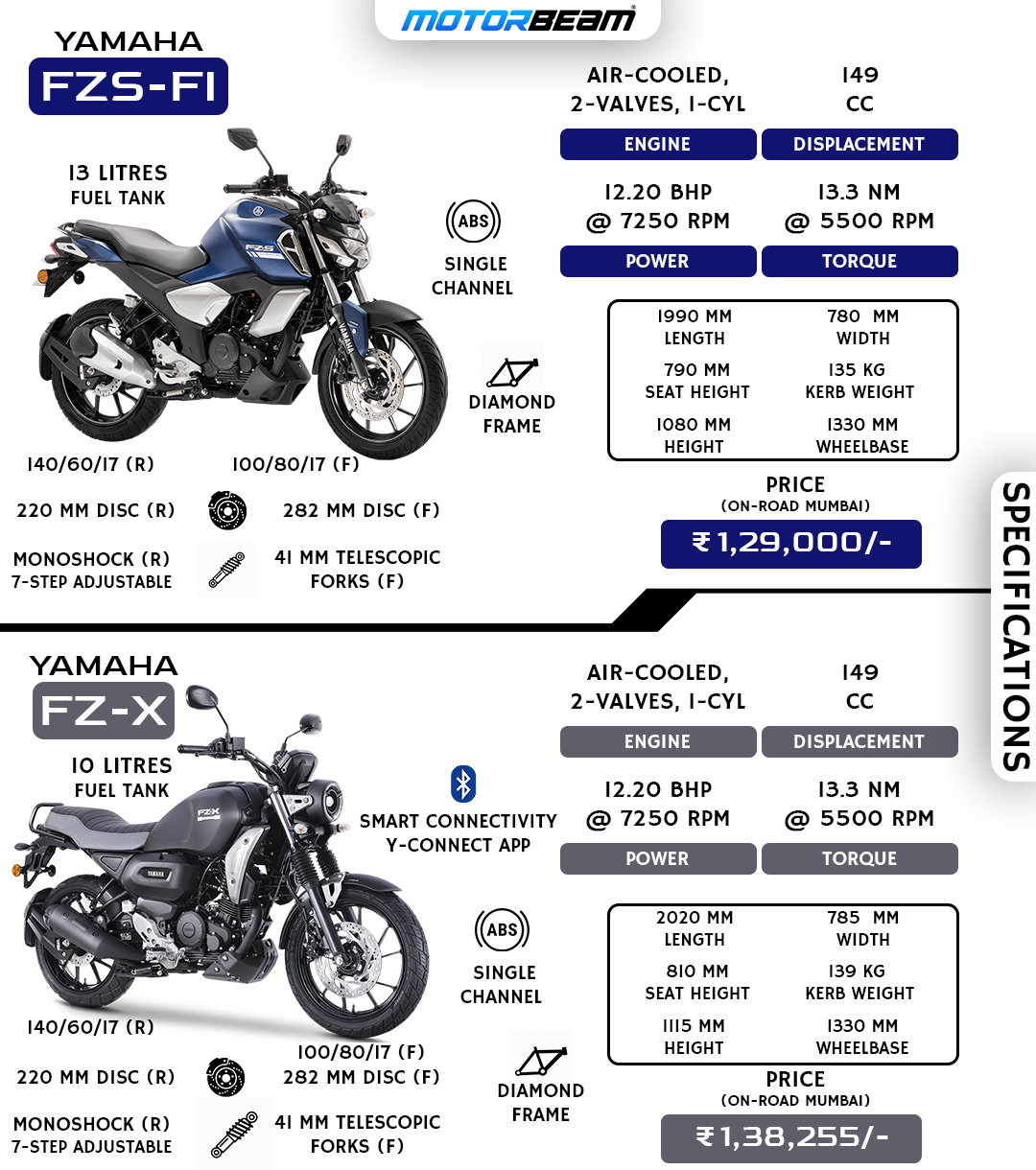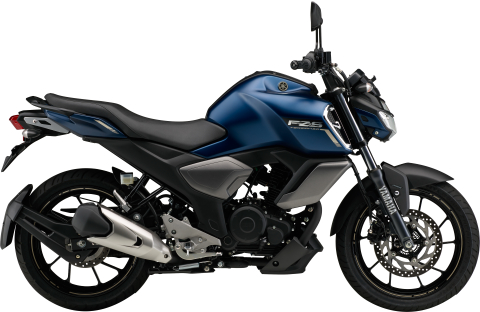Yamaha FZS-FI vs Yamaha FZ-X – Spec Comparison
Detailed spec comparison between Yamaha FZS-FI and Yamaha FZ-X.

Yamaha had launched the FZ-X in recent months and it has gained a lot of attention for different reasons and has become the talk of the town. In a nutshell, the FZ-X is based on the regular FZS. Everything from the chassis to the motor has been swapped out and put underneath a fresh swanky new neo-retro design which has has received contrasting opinions. With the FZ-X, Yamaha attempts to cater to an audience that craves neo-retro styling in the 150cc segment. The FZS, on the other hand, is a smart commuter motorcycle that had started the trend of peppy commuting but seems to have lost its character over the years. In this spec comparison, we highlight the differences that matter and help you thoroughly understand these bikes and choose the one you need.
The design language of the FZS is of a true-blue naked bike from Yamaha. And since its launch in 2014, it had continued to retain its macho streetfighter design. At the front, the headlight is a tri-split LED unit with a DRL in the chin area. However, the indicators are halogen-based which don’t look as appealing. The 41 mm telescopic forks look chunky and compliment the macho appeal of the bike. Moving towards the tank, it is decorated with shrouds that feature faux air-intakes dressed around in shiny chrome. The mass of the tank looks quite voluminous with the ‘L’ cuts and moulds on it. Towards the rear, the single-piece seat blends well with the commuter tag. The bike ends with a halogen taillight that is reminiscent of the original FZ.
The design of the FZ-X has split the world into two sets – there are people who adore it and there are people who absolutely hate it. Nevertheless, the FZ-X has taken inspiration from the XSR 155. It gets a round headlamp with a tri-split ring DRL and an LED projector in the centre. Here too, the indicators are bulb based and convey the retro look. The gated forks and short fender along with the block pattern tyre surely convey ruggedness and durability. Moving to the tank, it looks huge and has a neat knee recess followed by FZ-X lettering towards the front. Like the FZS, the FZ-X also has some fakery going on with its faux radiator cowls finished in contrast colour. Moving back, the dual-tone ribbed pattern seat doesn’t look as accommodating as on the FZS. Lastly, the LED taillight has a rectangle-type ovular shape.
The feature list on both the motorcycles is pretty much the same. Let’s check out the similar features first. Starting on the suspension front, both get the exact same suspension setup with 41 mm telescopic forks at the front and a mono-shock at the rear with 7-step adjustability. They have a 282 mm disc at the front and a 220 mm disc at the back for handling the stopping duties combined with a single-channel ABS as standard. Similarly, the headlight setup is LED-based with different implementations. The FZS gets a reflector-based LED set up with a unique “butterfly” shape, while the FZ-X approaches with a projector-based LED.
The biggest difference between the two is the type of tyres and not their size. As expected, the FZS gets traditional road tyres, while the FZ-X is the one that gets block pattern tyres, hinting towards better off-road capability. The FZ-X gets a larger and better instrument cluster that features Bluetooth connectivity as standard whereas it would cost you an extra Rs. 3000/- for the same on the FZS. Features of the Bluetooth system include trip time, total riding time, phone call alerts, messages, etc. Not to forget, the FZ-X offers a 12V power socket and a metal bash-plate which is a nifty addition as opposed to the fibre unit on the FZS. However, the FZS pushes the FZ-X back by 3-litres when it comes to fuel capacity as it has a larger 13-litre fuel tank while the FZ-X has a 10-litre unit.
Ergonomics are a very big differentiating factor between these two bikes. The FZS offers a slightly leaned in riding position as the handlebar is set flatter and much lower than the FZ-X. Combining this with the centre set footpegs enables the FZS to feel more engaging and sporty. The mirrors have a tapered shape and offer a decent view. Besides, the seat height at 790 mm is lower than the FZ-X by 20 mm making it slightly more accessible for short riders. However, we find the cushioning to be a bit too firm for our liking. However, the width and shape of the seat offers better support to your thighs and not having a ribbed seat enables you to move around a bit freely.
On the FZ-X, the ergonomic setup is relaxed and oriented towards comfortable cruising. The footpegs are forward-set and the handlebar is placed upright, taller and closer to the rider allowing for a comfortable upright seating position. The oval-shaped mirrors offer a very good view of what’s behind. Coming to the seat, it is placed at 810 mm and has a ribbed pattern with supple cushioning that offers promising comfort. However, the width of the seat is lesser than the FZS also, the space for the pillion is a bit less here. If you frequently carry a pillion with you, the FZS would be a better pick for you. But, if you want a soft and plush seat, you should prefer the FZ-X.
Commonly, both bikes have the same 149cc air-cooled engine in the same state of tune. This motor produces 12.20 BHP at 7250 RPM and 13.03 Nm of torque at 5500 RPM. However, the acceleration on the FZ-X is insignificantly slower than the FZS. This is because the bodywork has made it heavier by 4 kg. We all know the frugal nature of this 149cc mill. Here, both bikes return a similar fuel economy of 51-53 km/l. The riding range on the FZS lies at an impressive 676 km. While the number drops down to 520 on the FZ-X.
Since both bikes feature similar hardware, the difference between the way they ride and handle is almost non-existent. The telescopic forks and the mono-shock offer similar stability and feedback on both motorcycles. The chassis provides similar feedback and offers the same amount of flex. However, the tyres on these bikes are poles apart. The FZS sports road spec tyres handle the tarmac effortlessly. But tend to lose traction on dusty patches and muddy roads. While the FZ-X is equipped with dual-purpose block pattern tyres that are better at handling light to medium off-roading too. Dimension wise both bikes have a similar wheelbase of 1330 mm and have a similar braking setup. However, the FZ-X is 30 mm longer, 5 mm wider, 35 mm taller and 4 kg heavier than the FZS. However, these numbers do not make a noticeable difference in the real world.
The FZ-X demands a premium of Rs. 9255/-over the FZS. Hardware-wise, by paying that extra money, you are getting a metal bash-plate, Bluetooth connectivity, dual-purpose tyres, better instrument cluster and relaxed ergonomics which sounds somewhat reasonable. In conclusion, if you like the relaxed ergonomics and the neo-retro design, you should pick the FZ-X. While the FZS looks and feels like the true-blue street naked motorcycle and, if you like that, you should pick the FZS.

